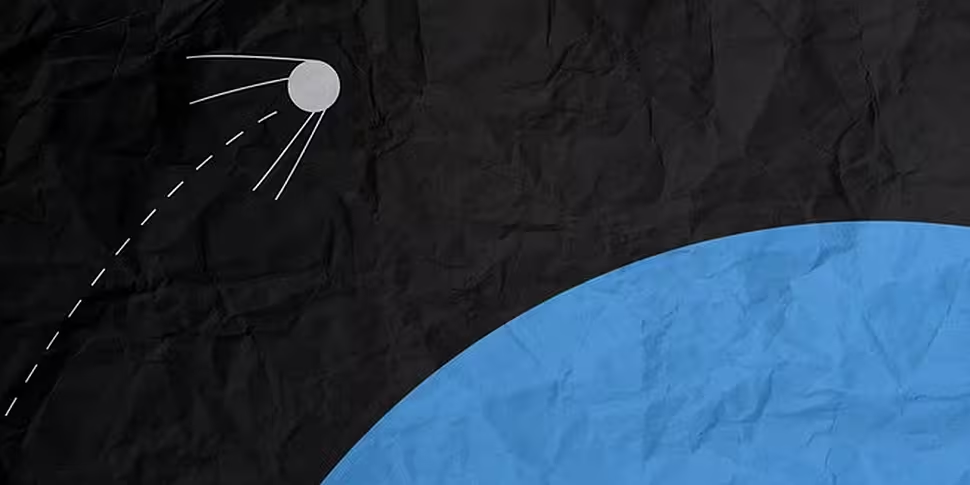Almost 60 years ago today, mankind managed to get the first artificial satellite to orbit the Earth, with a tiny Russian space craft blazing the beeping trail across the sky that opened the door for some of the greatest scientific achievements ever carried out. Sputnik 1, the little ball that got the space race rolling.
The brainchild of the chief Soviet rocket scientist Sergei Korolev, the plans for the satellite that would become a worldwide symbol of the future were first mooted in 1954. The Soviet plan came about a year before US President Eisenhower declared that the American space agency NASA would attempt to launch its own artificial satellite into orbit during the much-feted International Geophysical Year – a 15-month long commitmen by nations of the world beginning on July 1st, 1957 to participate and share scientific research like never before.
Despite ‘Object PS’ being a drastically reduced version of the original, the plucky satellite that blasted off the Earth from the Baikonur Cosmodrome in what is now Kazakhstan truly was a pioneering piece of scientific engineering.

Radio Moscow's international propaganda poster in honour of Sputnik
At 1:28am local time on October 5th, an R-7 intercontinental ballistic missile, the biggest and most powerful in the world at the time, sent the 82kg and 52cm-wide ball hurtling into the sky. 295 seconds later, having reached 228 kilometres into the heavens, the thrust cut out, a series of pneumatic locks clicked open, shedding the nosecone to reveal the ball inside. The small sphere was then pushed from its rocket, pulling out into space, taking its four tendril-like antennas with it. Sputnik 1 had made orbit.
Sputnik had been equipped with temperature and pressure sensors, and transmitted some groundbreaking data about the environment it was floating through. Based on the readings it radioed back to Russia’s space scientists, the Soviets were able to work out the density of Earth’s upper atmosphere by studying the drag on the spacecraft. Sputnik’s radio signals were also used to map out the electron distribution in the ionosphere.
But perhaps its most significant scientific discovery was merely the proof-of-concept that an artificial satellite could continue to orbit the Earth and escape her gravitational pull if it was travelling fast enough.

A Soviet stamp commemorating the fifth anniversary of Sputnik 1's successful launch [Wikipedia]
For three weeks, the beeping beach ball blew the world’s mind, transmitting its continual radio beep to scientists, government agencies, and anyone with a strong radio receiver. The craft’s iconic beep-beep-beep captivated a global audience of millions, and continued to ping its reassuring presence until Sputnik’s batteries ran out after three weeks running rings around the planet on October 27th.
Sputnik’s surprise success had an indelible impact on popular culture, ignited the space race rivalry between the world’s two superpowers, and forever changed space exploration. While the beeping satellite also struck fear into the heart of Uncle Sam at the growing military might of the Soviet Union, as a piece of scientific apparatus, Sputnik inspired the engineers of the world to look to the skies as a place to aspire for.
In the years since, we’ve sent men to the moon, probes to Pluto, landing spacecraft on a comet, sent something manmade beyond the boundaries of our solar system, seen further than ever before, and just discovered flowing water on a planet we all thought was a desert.
And all of that work owes so much to the beeping aluminium beach ball that kicked its way across the sky on a cold night in Kazakhstan in October, 1957.
Even after the beeps had stopped, the satellite was tracked by ground telescopes, providing the scientific community with information about high-altitude atmospheric density. On January 4th, 1958, having completed almost 1,400 orbits of the Earth and travelling nearly 70m kilometres, the little probe that could finally burned up in the atmosphere.
Sputnik’s surprise success had an indelible impact on popular culture, ignited the space race rivalry between the world’s two superpowers, and forever changed space exploration. While the beeping satellite also struck fear into the heart of Uncle Sam at the growing military might of the Soviet Union, as a piece of scientific apparatus, Sputnik inspired the engineers of the world to look to the skies as a place to aspire for.
In the years since, we’ve sent men to the moon, probes to Pluto, landing spacecraft on a comet, sent something manmade beyond the boundaries of our solar system, seen further than ever before, and just discovered flowing water on a planet we all thought was a desert.
And all of that work owes so much to the beeping aluminium beach ball that kicked its way across the sky on a cold night in Kazakhstan in October, 1957.









